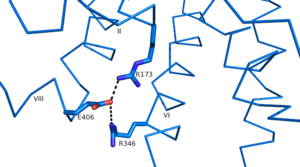This is a default text for your page '. Click above on edit this page' to modify. Be careful with the < and > signs.
You may include any references to papers as in: the use of JSmol in Proteopedia [1] or to the article describing Jmol [2] to the rescue.
Background
G-protein coupled receptors
Function
Structure
Class B structural components
As opposed to class A glucagon receptors which have a proline kink, in all secretin-like class B glucagon receptors there is a Glycine at position 393 in Helix VII which allows for a . This Glycine and therefore this helical bend is fully conserved in all secretin-like class B receptors and is an important part of the FQGxxVxxYCF motif.
Another important structural component found in all secretin-like class B receptors are the two conserved salt bridges found between Arg 346 and Glu 406 and Arg 173 and Glu 406
.
Since there is no conservation of these residues in class A receptors these salt bridges are likely an important feature of secretin-like class B receptors.
Disulfide bonds
As a part of the interface stabilization between helices VI, V, and III, a class B specific hydrogen bond occurs between N 318 of Helix V and L 242 of Helix III.
unique components to GPCR
An important interface stabilization interaction between helices I and VII occurs between Ser 152 of Helix I and Ser 390 of Helix VII. Due to their close proximity to one another, they form an important which serves to stabilize the structure of GCGR.
Clinical Relevance
clinical relevance
</StructureSection>
References
- ↑ Hanson, R. M., Prilusky, J., Renjian, Z., Nakane, T. and Sussman, J. L. (2013), JSmol and the Next-Generation Web-Based Representation of 3D Molecular Structure as Applied to Proteopedia. Isr. J. Chem., 53:207-216. doi:http://dx.doi.org/10.1002/ijch.201300024
- ↑ Herraez A. Biomolecules in the computer: Jmol to the rescue. Biochem Mol Biol Educ. 2006 Jul;34(4):255-61. doi: 10.1002/bmb.2006.494034042644. PMID:21638687 doi:10.1002/bmb.2006.494034042644

